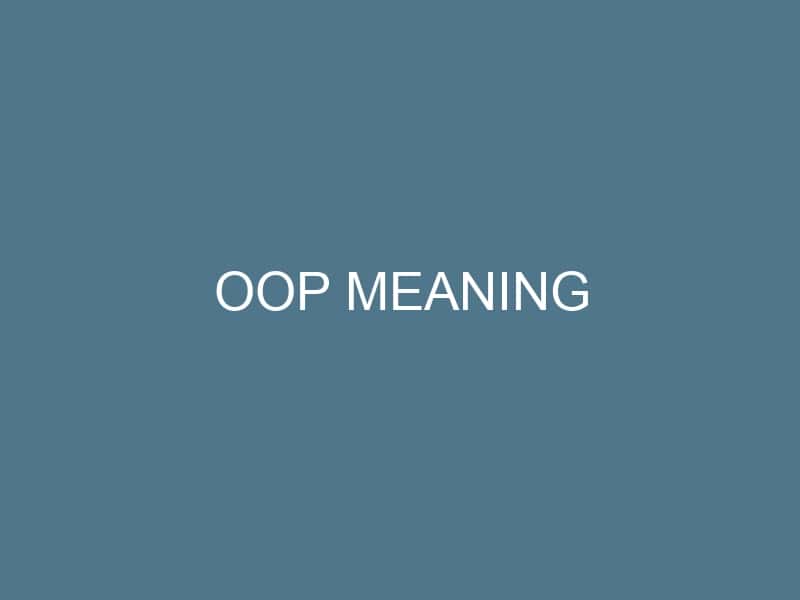Object-Oriented Programming, commonly known as OOP, is a programming paradigm centered around objects rather than actions. The core concept involves creating objects that represent real-world entities and thus can hold data and methods that operate on the data. Understanding the principles of OOP is vital due to its prevalent use in software development. It enables programmers to create modular, reusable, and maintainable code, aligning with real-world phenomena.
The importance of grasping these programming concepts cannot be overstated. As technology increasingly intersects with every facet of work and life, possessing a clear understanding of fundamental programming concepts like OOP provides individuals with an essential toolkit for problem-solving beyond the domain of traditional software development.
Key Takeaways of Object-Oriented Programming
Object-Oriented Programming (OOP) is a crucial concept in software development that focuses on designing software around objects rather than actions. To understand OOP is to have a deeper insight into programming languages and applications that utilize this paradigm. It facilitates programming through modular, reusable, and scalable code.
Here’s a summary of the key points discussed in the article:
| Principle | Definition | Benefits |
|---|---|---|
| Encapsulation | Bundling data with the methods that manipulate it, like a letter within an envelope, providing security, simplicity, and maintainability of the code. | Protects data from unauthorized access and allows for flexible code changes. |
| Abstraction | Presents only the necessary features of an object, simplifying the complexity of system design and increasing code reusability by hiding detailed implementations. | Simplifies the object handling for users and reduces the complexity of the development process. |
| Inheritance | Enables a new class to inherit properties and behaviors of an existing class, establishing an “is-a” relationship, like a Dog class inheriting from an Animal class. | Encourages code reusability and facilitates polymorphism through a clear hierarchical structure. |
| Polymorphism | Allows objects to be treated as instances of their parent class, rather than their actual class, supporting “one interface, multiple implementations.” | Enables a flexible and dynamic selection of methods, fostering code reusability. |
OOP is implemented by a variety of programming languages, each with its unique characteristics:
- Java: Emphasizes on clean OOP practices and is a staple in enterprise environments.
- C++: Adds OOP functionality to C, providing in-depth control over system resources.
- Python: Known for its approachable syntax, making OOP concepts readily accessible to beginners and professionals alike.
- C#: Microsoft’s strong, safe, OOP-centric language.
The use of OOP extends across various industries and has been a game-changer in the development of web applications, video games, and large-scale enterprise systems.
When put in contrast with other programming paradigms such as procedural and functional programming, OOP distinguishes itself by its object-centric approach, which aligns closely with how people understand and interact with the world around them.
Additionally, understanding OOP can help demystify the broader lexicon of technical jargon, including internet and tech acronyms such as BTC Meaning and TYT Meaning.
In essence, the foundational concepts of OOP—encapsulation, abstraction, inheritance, and polymorphism—form the bedrock of efficient, logical, and clean code that is maintainable and scalable, and they are vital for anyone looking to delve into the realm of software development.
Core Principles of OOP
The four pillars of OOP delineate the framework on which object-oriented programming stands:
- Encapsulation: Binds data with the code that manipulates it.
- Abstraction: Hides the complex reality while exposing only the necessary parts.
- Inheritance: Allows classes to inherit features from other classes.
- Polymorphism: Gives a way to use a class exactly like its parent so there’s no confusion with mixing types.
These principles help manage software complexity by enabling more abstract thinking about the data structures and operations in a system.
Encapsulation in OOP: Protecting the Data
Encapsulation is likened to an envelope that contains a letter. It shields the contents (data) from unauthorized access and manipulation by bundling the data with code that is allowed to access it. The letter (data) is only accessible by the designated route (methods), keeping it secure from outside interference.
The benefits of encapsulation include:
- Improved Security: Restricts direct access to some of an object’s components.
- Simplicity: Makes the object more straightforward to use correctly.
- Flexibility and Maintainability: Allows the developer to change one part of the code without affecting other parts.
Abstraction: Simplifying Complexity
Abstraction in OOP denotes the concept of hiding the complex reality while exposing only necessary parts. Much like using a remote control to operate a television without knowing the inner workings, abstraction lets programmers leverage complex code without understanding all the details of how that code works.
Advantages of abstraction are:
- Simplified View of an Object: Only the relevant attributes and methods are exposed.
- Reduced Complexity: Implementation details are hidden, reducing the complexity of software design.
- Increased Reusability: Promotes code reuse by focusing on the interface over the implementation.
Inheritance: Building on Existing Solutions
Inheritance is structuring a new class (child) to take on properties and behaviors of an existing class (parent). This creates an “is-a” relationship, for example, a “Dog” class might inherit from an “Animal” class, implying that a dog is an animal.
Inheritance benefits and use cases include:
- Code Reusability: Inheriting attributes and methods from the base class.
- Easy to Implement Polymorphism: Using inherited methods to perform different tasks.
- Hierarchical structure: Reflects real-world relationships in code.
Polymorphism: Flexibility in Objects
Polymorphism in OOP is an advanced concept that can be described succinctly as “one interface, many implementations.” It allows objects to be treated as instances of their parent class rather than their actual class. The two types of polymorphism include:
- Static Polymorphism: Method overloading.
- Dynamic Polymorphism: Method overriding.
The impacts of polymorphism are:
- Code Reusability: Similar to inheritance, allows for the reuse of software components.
- Flexibility: Enables multiple implementations of a method to exist, which can be selected dynamically at runtime.
Object-Oriented Programming Languages
Several popular programming languages implement OOP principles, each with its own set of features:
- Java: Offers a clean OOP methodology and is widely used in enterprise environments.
- C++: Extends the C language with OOP features, offering low-level memory manipulation capabilities.
- Python: Provides a user-friendly approach to OOP with its easy-to-understand syntax.
- C#: Leverages OOP principles in a robust, type-safe language designed by Microsoft.
OOP in the Wild: Practical Applications
OOP has a prominent role in the world of software engineering and is used across various industries:
- Web Development: Frameworks like Ruby on Rails and Django rely on OOP concepts for structure.
- Game Development: Allows developers to create complex characters and environments with inheritable properties.
- Enterprise Applications: Systems like CRM or E-commerce platforms frequently employ OOP for better modularity.
Connecting the dots, you’ll find OOP concepts in everyday technology, from the apps on your smartphone to the software in your car.
Comparing OOP with Other Programming Paradigms
It’s important to understand how OOP differs from other paradigms such as:
- Procedural Programming: Focuses on procedures or routines rather than data structures.
- Functional Programming: Based on the evaluation of mathematical functions and avoidance of state and mutable data.
Each paradigm comes with its own set of principles and uses cases, making them better suited for certain types of problems.
Understanding Common Acronyms in the Tech World
Learning technical definitions such as those inherent in OOP can aid in understanding and decoding the jargon that is rife within the realm of technology. Knowing the meanings behind common internet and tech acronyms is also quite practical and beneficial.
Here’s a list of various commonly used tech acronyms:
- BTC Meaning
- TYT Meaning
- FR Meaning
- TTM Meaning
- ISTG Meaning
- IHHT
- LMS Meaning
- IMU Meaning
- HYB Meaning
- FYP Meaning
- …
Conclusion
This overview of OOP has covered key concepts like encapsulation, abstraction, inheritance, and polymorphism. The principles of OOP lay the foundation for writing efficient, logical, and clean code that is maintainable and scalable. Its significance in modern programming and widespread application across industries underlines the value of OOP in developing robust and flexible software solutions. For those intrigued by the potential of OOP, there is a vast landscape of knowledge to explore and master, as it is a cornerstone of a career in software development.








1 thought on “OOP Meaning”